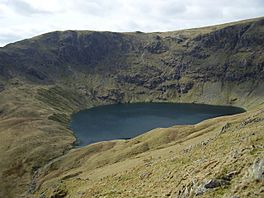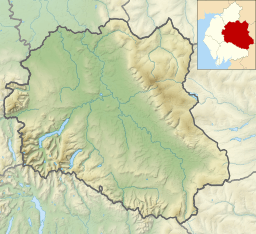Blea Water facts for kids
Quick facts for kids Blea Water |
|
|---|---|

Blea Water viewed from above
|
|
| Location | England |
| Coordinates | 54°29′20″N 2°51′10″W / 54.48889°N 2.85278°W |
| Type | glacial lake |
| Basin countries | United Kingdom |
| Max. depth | 206 ft (63 m) |
| Surface elevation | 1,550 ft (470 m) approx. |
Blea Water is a special kind of lake found in the Lake District, England. It's known as a tarn or a corrie lake. This beautiful lake sits in a bowl-shaped hollow. This hollow was carved out by ancient glaciers. You can find Blea Water just east of a famous mountain called High Street.
Blea Water is quite deep for its size. It goes down more than 200 feet (about 61 meters). This makes it the deepest tarn in the entire Lake District. It's a peaceful spot, high up in the mountains.
Contents
Discovering Blea Water
Blea Water is located in the stunning Lake District National Park. This park is in the county of Cumbria, England. The lake is part of the Eden District. It sits high up in the mountains, about 1,550 feet (472 meters) above sea level.
The Lake District is famous for its beautiful scenery. It has many lakes, mountains, and valleys. Blea Water is one of the hidden gems in this area. It offers amazing views for anyone who visits.
What is a Tarn?
A tarn is a type of mountain lake. It forms in a hollow that was once filled with ice. These hollows are often shaped like a bowl or an armchair. They are called cirques or corries.
Tarns are usually found in areas that had glaciers in the past. When the ice melts, it leaves behind a lake. Blea Water is a perfect example of a tarn. It shows how powerful glaciers can be.
How Blea Water Was Formed
Blea Water was created by glaciers. Thousands of years ago, huge sheets of ice covered this area. As these glaciers moved, they slowly scraped away at the rock. This process is called glacial erosion.
The glaciers dug out the bowl-shaped hollow where Blea Water now sits. When the climate warmed, the ice melted. The melted water filled the hollow, forming the lake. This is why Blea Water is called a "glacially excavated" lake.
Exploring the Area Around Blea Water
The area around Blea Water is perfect for outdoor adventures. Many people enjoy hiking to the lake. The path can be steep, but the views are worth it. You can see rolling hills and other mountains.
The lake is a quiet place. It's a great spot for nature lovers. You might see different types of birds or plants. The air is fresh and clean. It's a wonderful place to relax and enjoy nature.
Wildlife and Nature
Even though Blea Water is high up, it supports some wildlife. You might find small fish in the lake. Various insects also live near the water. Birds like ravens and buzzards can often be seen flying overhead.
The plants around the lake are hardy. They are used to the mountain weather. You'll see tough grasses and mosses. In some spots, you might find small wildflowers. They add splashes of color to the landscape.
High Street and the Lake District
Blea Water is located near High Street. High Street is a mountain in the Lake District. It gets its name because the Romans built a road over its summit. This road was once a "high street" or main route.
The Lake District National Park is a protected area. It helps to keep places like Blea Water wild and beautiful. It's important to respect the environment when visiting. This ensures everyone can enjoy its natural wonders.
Fun Facts About Blea Water
- Blea Water is the deepest tarn in the Lake District. It goes down over 200 feet!
- It sits about 1,550 feet (472 meters) above sea level.
- The lake was formed by ancient glaciers.
- It's located in the eastern part of the Lake District.
- The name "Blea" might come from an Old Norse word meaning "dark" or "blue."
- It's a popular spot for hikers and nature enthusiasts.




